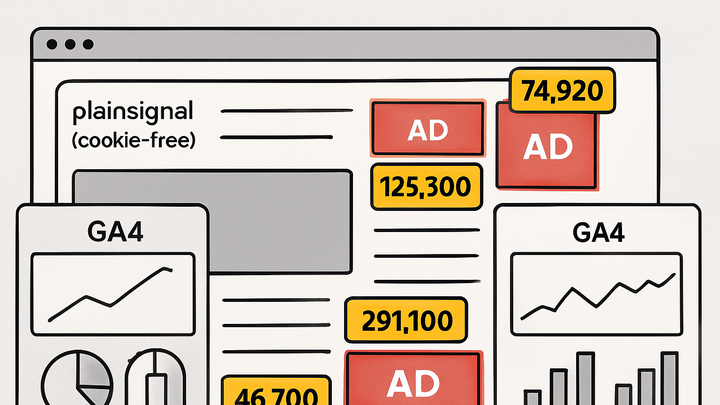Published on 2025-06-22T01:43:30Z
What is an Ad Impression? Examples with PlainSignal and GA4
Ad Impressions are a fundamental metric in digital advertising that count the number of times an ad creative is fetched and rendered on a user’s screen. While impressions do not indicate direct user engagement, they serve as the baseline for measuring ad visibility and reach. Accurately tracking impressions allows advertisers to calculate metrics such as CPM (cost per thousand impressions), evaluate campaign performance, and make data-driven decisions about budget allocation and creative optimization. In privacy-focused environments, cookie-free analytics platforms like PlainSignal track impressions using unique pageview signals, ensuring compliance with regulations like GDPR while preserving data accuracy. Meanwhile, Google Analytics 4 (GA4) can capture ad impression events through its event-based model, integrating them with user behavior data for a holistic view of ad impact. By understanding and comparing impressions across platforms, marketers can refine targeting strategies, improve ad placements, and maximize return on ad spend (ROAS).
Ad impressions
The number of times an ad is fetched and displayed, key for measuring ad visibility and reach.
Understanding Ad Impressions
This section defines what ad impressions are, how they differ from clicks, and why they are foundational for measuring campaign reach.
-
Definition of an impression
An ad impression occurs each time an ad is fetched from the server and displayed on a user’s screen. Impressions count raw ad loads, not guaranteeing that the ad was fully in view or interacted with.
-
Importance in campaign measurement
Impression data helps determine the potential audience size, calculate CPM rates, and benchmark campaign reach. High impression counts signal broad ad exposure, while low counts may indicate poor placement or technical issues.
Tracking Ad Impressions in Analytics Tools
Different analytics platforms implement ad impression tracking uniquely. Here’s how PlainSignal and GA4 handle it.
-
Cookie-free tracking with PlainSignal
PlainSignal uses a lightweight, privacy-focused script to record ad impressions without relying on cookies or third-party trackers. It captures page-level ad loads and reports aggregated counts in real time.
-
Implementation example
<link rel="preconnect" href="//eu.plainsignal.com/" crossorigin /> <script defer data-do="yourwebsitedomain.com" data-id="0GQV1xmtzQQ" data-api="//eu.plainsignal.com" src="//cdn.plainsignal.com/plainsignal-min.js"></script>
-
-
Event-based tracking in GA4
Google Analytics 4 tracks ad impressions as custom events or via enhanced measurement for certain ad integrations. You can define an ‘ad_impression’ event with parameters like ad_unit, campaign, and creative_id.
-
GA4 event setup example
gtag('event', 'ad_impression', { 'ad_unit': 'banner_1', 'campaign': 'spring_sale', 'creative_id': 'creative123' });
-
Best Practices for Accurate Impression Measurement
To ensure reliable impression data, follow these best practices across tracking implementation and data analysis.
-
Ensure viewability
Complement raw impressions with viewability metrics to filter out impressions where the ad was not actually seen by the user (e.g., below the fold).
-
Filter non-human traffic
Implement bot filtering and exclude known crawlers to avoid inflated impression counts from automated traffic.
-
Regularly audit tracking setup
Periodically test and verify that your tracking scripts load correctly across different browsers and ad positions to prevent missing or duplicate impressions.
